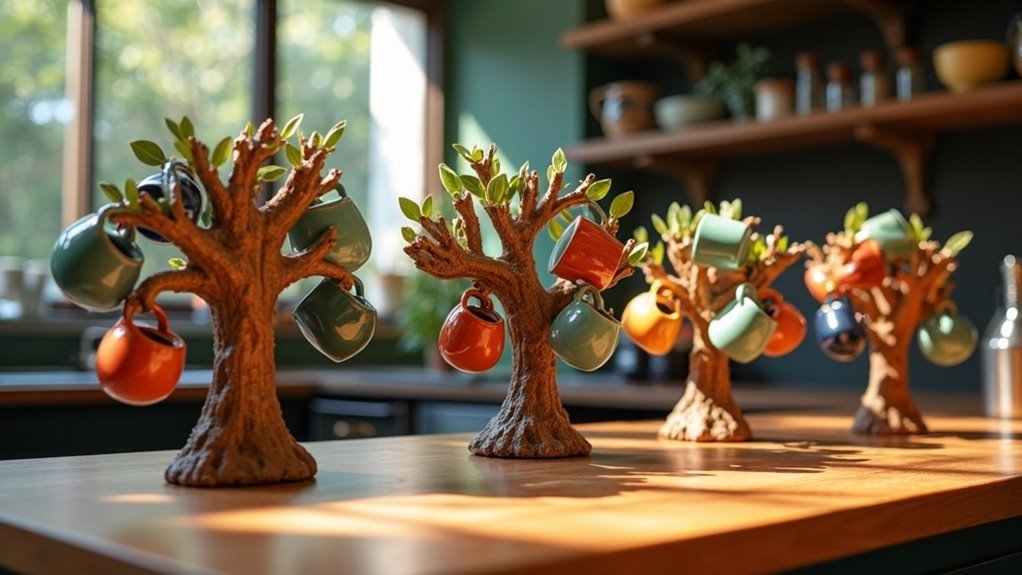The Turkish ibrik is an essential pot specifically designed for brewing traditional Turkish coffee, a beloved beverage celebrated for its rich flavor and cultural heritage. Its wide base guarantees stability and even heat distribution, while a narrow neck concentrates the foam, enhancing the coffee’s flavor and preventing spills. Typically made of materials like copper or stainless steel, the ibrik features a long handle for safe and easy use. This unique vessel embodies craftsmanship and hospitality, inviting a shared coffee experience that is central to Turkish culture. Explore its preparation techniques and cultural significance to fully appreciate the art of brewing Turkish coffee.
Key Takeaways
- An ibrik is a traditional coffee pot specifically designed for brewing Turkish coffee, which is also referred to as cezve in certain regions.
- It has a wide base for stability, a narrow neck to concentrate the rich foam, and a long handle for safe and easy pouring.
- The brewing process involves mixing finely ground coffee with cold water and heating it gently to produce a luscious foam known as köpük.
- The ibrik not only represents hospitality and craftsmanship but also enhances social interactions and elevates the overall coffee experience.
- It serves as a connection between individuals across centuries of coffee culture, showcasing both the aesthetic appeal and traditional methods of preparation.
Characteristics of an Ibrik for Coffee Brewing
The ibrik, a quintessential tool in Turkish coffee brewing, showcases a unique design that greatly enhances the coffee-making experience.
This Turkish coffee pot features a wide base for stability and even heat distribution, optimizing the brewing process for a rich and flavorful cup of coffee. Its narrow neck concentrates the foam and minimizes spills, ensuring a cleaner pour every time.
This Turkish coffee pot’s wide base and narrow neck ensure optimal brewing and a clean, foam-rich pour every time.
Crafted from materials like copper or modern stainless steel, each ibrik is designed for both functionality and aesthetics, making it a beautiful addition to any coffee lover’s collection.
The long handle allows for safe handling, keeping your hands away from heat, while its shape is perfected for creating the coveted köpük, enhancing the taste and tradition of Turkish coffee, especially when using finely ground coffee.
How to Use an Ibrik for Coffee
Using an ibrik for coffee involves a series of deliberate steps that guarantee an authentic brewing experience.
Start by mixing finely ground Turkish coffee and cold water in the ibrik, adding sugar if you like, but don’t stir.
Heat it gently over low to medium heat, carefully watching to avoid boiling, and remove just before it bubbles to preserve the foam.
After cooling for 20 seconds, return it to heat for rich foam, repeating as needed.
When serving, pour into small cups, ensuring the foam (köpük) is evenly distributed while letting the grounds settle at the bottom of the ibrik.
Ibrik vs. Cezve
When you explore the terms “ibrik” and “cezve,” you’ll notice how regional usage shapes their meanings and significance within the coffee culture.
While both refer to the same essential coffee pot, “ibrik” often encompasses a wider variety of pitchers used for brewing coffee, whereas “cezve” is specifically associated with the preparation of Turkish coffee.
Understanding these distinctions not only enhances your appreciation of coffee but also highlights the unique brewing traditions and practices across different regions.
Terminology Differences Explained
Understanding the distinction between “ibrik” and “cezve” enriches your appreciation of coffee culture.
While “ibrik” broadly refers to various pitchers or pots, “cezve” specifically denotes the traditional Turkish coffee pot used for brewing.
In Western contexts, you might hear “ibrik” more often associated with the coffee pot, yet “cezve” captures its cultural essence.
This terminology difference showcases regional nuances, with “ibrik” recognized in Arabic-speaking areas and “cezve” in Turkey.
Both serve the same brewing methods, yet their names reflect rich local traditions, enhancing your understanding of the cultural significance behind coffee preparation.
Regional Usage Variations
The distinction in terminology between “ibrik” and “cezve” extends beyond mere words; it reflects the rich tapestry of coffee culture across different regions.
In Arabic-speaking areas, you’ll hear “ibrik,” while in Turkey, “cezve” reigns supreme, specifically referring to the coffee pot. Greece offers “briki,” showcasing yet another variation.
Despite these terms, both the ibrik and cezve share similar designs and functionality, serving the same purpose—brewing traditional coffee.
These regional nuances highlight cultural distinctions, as each area emphasizes its unique customs and brewing techniques, enriching the global appreciation of coffee.
Cultural Significance of the Ibrik
While many may see the ibrik merely as a tool for brewing coffee, its cultural significance in Turkish society is profound. This traditional vessel represents centuries of craftsmanship and hospitality, playing a crucial role in social interactions.
Serving coffee from an ibrik embodies values such as patience and precision, inviting guests into a shared experience that transcends mere consumption. Its unique design not only enhances the brewing process but also showcases an appreciation for aesthetics.
Known by various names across cultures, the ibrik serves as a bridge that connects individuals through the rich history of coffee, turning each cup into a cherished moment of connection and tradition worth savoring.
Ibrik Brewing Specs
Crafting the perfect cup of Turkish coffee in an ibrik requires attention to detail and a grasp of specific brewing specs that enhance the overall experience. To achieve the best flavor, use a coffee-to-water ratio of 1:10, with 60 mL of extra-fine grind coffee, which should resemble powdered sugar. Heat the water to around 208°F (98°C) and maintain medium heat throughout the brewing process. Allow 10 to 15 minutes for brewing to effectively extract rich flavors.
| Parameter | Specification | Notes |
|---|---|---|
| Coffee Grind | Extra-fine | Resembles powdered sugar |
| Brew Time | 10-15 minutes | Ideal for flavor extraction |
| Coffee-to-Water | 1:10 | Best for a rich taste |
Step-by-Step Brewing Instructions: The Ibrik
To brew Turkish coffee successfully using an ibrik, start by carefully measuring and grinding high-quality Arabica beans to an extra-fine consistency, resembling powdered sugar.
Mix this coffee with cold, filtered water in a 1:10 ratio. Gently heat the ibrik over low flame, stirring until foam forms, but avoid letting it boil.
Just before it reaches a boil, remove the ibrik to capture the foam, or wesh. After a brief cool-down, you can return it to the heat for more foaming if desired.
Finally, pour slowly into demitasse cups, allowing the grounds to settle before savoring your rich, aromatic Turkish coffee.
Tips for Brewing Coffee With an Ibrik
Brewing coffee with an ibrik offers a unique opportunity to enhance your coffee experience through careful attention to detail.
Start with an exceptionally fine grind, ideal for optimal extraction. Use cold, filtered water with a 1:10 coffee-to-water ratio; for instance, 10 grams of coffee in 100 ml of water.
Heat the pot over low flame, removing it just before boiling to prevent spills and maintain that rich foam, known as wesh. You can repeat this heating process for even more foam.
Finally, let the coffee rest briefly to allow the grounds to settle, ensuring a smooth drinking experience.
Coffee Recommendations for Turkish Ibrik
What makes a coffee truly exceptional when brewed in an ibrik? Start with high-quality Arabica beans, such as DaLat Coffee or Café Najjar, which are renowned for their rich and bold flavors.
Grind the coffee into small, extra-fine particles, similar to powdered sugar, to ensure ideal extraction and achieve that signature foam (wesh). For the perfect brew, use a coffee-to-water ratio of 1:10, mixing 10 grams of coffee with 100 milliliters of water.
If you enjoy a touch of sweetness, add sugar before heating to ensure even distribution. Brands like Kurukahveci Mehmet Efendi and Mariam Turkish coffee stand out for their exceptional flavor, making them perfect choices for your ibrik.








